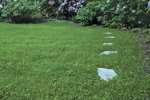

This time of year, the morning sun enters the house at the perfect angle to shine light on how much dust and cobwebs have accumulated in the living room, signaling that spring is almost here.
Inevitably, that means spring cleaning, which also means I’ll be outside if you need me.
I head outside to my domain, where a trim of the hedge, prune of the trees, and a trip to the nursery can make a huge difference for significantly less time and energy than any interior project would require.
That is, until I get to the lawn.
I think it’s time to be honest with ourselves: Grass is a pain in the you know what, especially for us forest dwellers. In the past 17 years that my family has lived out here, there hasn’t been a single season where we haven’t had to completely re-establish the lawn.
No matter how much amending, aerating or thatching we do, our soil remains too acidic, too heavy in clay, and generally inhospitable for whatever species of seed came in the name brand bag we bought from the local big box store. There’s no other plant in the yard that needs as much assistance to survive as the grass. It must be mowed, fertilized and watered constantly, or else it dies. And to think, all this effort for a plant we can’t even eat.
Naturally, it’s no secret in my household that if I could get rid of the grass and turn the lawn into more garden, I would have started yesterday. However, I’m outvoted every year because apparently, we need the open space for “activities,” even though nobody’s busted out the bocce balls since 2010.
But thanks in part to prolonged summer droughts, there has been a shift in grass lawn sentiment over the past couple years. The ecological necessity for alternative landscaping solutions presents me with the perfect opportunity to find compromise with the ole family about how best to cultivate the lawn space.
While convincing them to let me put in more gardens has been a futile pursuit, a more palatable solution has come across my radar that I think we can all get behind. It’s something that allows us to keep our open spaces while also providing an opportunity to get creative with how we reinvent our landscape to be more water conscious, and all-around beneficial to us and the ecosystem at large.
Eco-lawns are gaining traction as the perfect alternative to traditional grass lawns. There are different versions, which include bee lawns, no-mow (only twice a year is the claim), clover lawns, meadows (different from bee-lawns), and even fodder mixes for chickens and other small farm animals. Mixes are also region- and site-specific, which means there’s an eco-lawn mix available for just about any yard no matter where you live.
They’re actually more of a classic revival, as the first lawns (dating as far back as 16th century England and France) were made up of a mixture of different plants like chamomile and thyme. Even clover was encouraged to be cultivated with grass due to its nitrogen fixing capabilities, but with the adoption of broadleaf herbicides in the 1950s, clover ended up classified as a weed and as a result single-species grass lawns became the cultural norm, along with the necessary purchase and application of nitrogen-rich fertilizers every year.
As opposed to a conventional bag of grass seed, eco-lawn mixes help to build a diverse and resilient turf habitat through the inclusion of various species of grasses, flowers and groundcovers. Each plant featured in a mix is meant to play a role that supports the others as well as contributes to the function of the landscape.
Eco-lawns are designed to be drought tolerant and low maintenance once established, but what does it take to make the transition? Ideally, site preparation would take a full growing season, especially if you’re trying to replace an existing lawn, because you’ll need to cultivate the space and cover it with a black tarp to fully kill the grass or any weed seeds in the soil. But, if your lawn is already struggling like ours, then you’re already halfway there.
You can sow the seeds into an existing lawn, but it will take a bit longer for the new species to establish. If you’re impatient, like me, but want better odds, you can also spread a layer of topsoil (nothing fancy) over the areas you want to reseed. Spring sowings will more than likely need supplemental irrigation over the summer to ensure survival, but after the first season, the new lawn will be able to take care of itself. And if there’s anything about a lawn worth exerting effort over, it’s for that glorious end goal. But also the bees, of course.
UNDERWRITTEN BY THE FUND FOR NONPROFIT NEWS (NEWSMATCH) AT THE MIAMI FOUNDATION, THE ANGEL GUILD, ADVERTISERS, DONORS AND PEOPLE WHO SUPPORT INDEPENDENT, NONPROFIT LOCAL NEWS